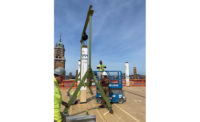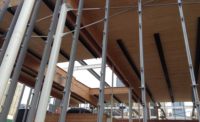The team behind Cleveland’s 512,000-sq-ft, eight-story INTRO apartment/retail complex unlocked the construction efficiencies of cross-laminated and mass timber.
James Litwin, vice president of construction at developer Harbor Bay Real Estate Advisors, was intrigued by the possibilities of mass timber construction for residential and mixed use ever since he saw T3—the first mass-timber-framed building higher than five stories in the U.S.—go up in Minneapolis in 2017.
Litwin has held senior management positions at ENR Top 100 construction companies across the country and has managed over $1 billion in construction projects. He also worked on old heavy timber reconstruction projects over his 30 years in the business before attempting Cleveland’s $150-million INTRO building.

Cleveland’s INTRO nears completion. At eight stories, it will briefly be the tallest mass timber structure in the U.S.
Photo by Jeff Yoders for ENR
When Harbor Bay CEO Mark Bell and Dan Whalen, vice president of design and development, brought the idea of a residential and retail mixed-use project in Cleveland’s Ohio City neighborhood to the team in 2018, Litwin wasn’t concerned about size or height, what interested him most was unlocking the efficiencies of building with glulam columns and beams, mostly CLT floors and concrete elevator cores.
Hartshorne-Plunkard Architecture (HPA) of Chicago’s design called for a V-shaped structure that fits 298 apartments, 10 penthouses, 36,000 sq ft of ground-floor retail and a 12,000-sq-ft truss event space at the top with stunning views of downtown Cleveland and Lake Erie. A 1.5-acre pedestrian plaza connects the project to Cleveland’s historic West Side Market across 25th Street. At over $100 million to construct, the price and the available land parcel were right, but to deliver the INTRO at that cost, Litwin got involved to assist contractor Panzica Construction in the burgeoning field of mass timber building.

The truss event space has a thicker floor than the others to allow for more acoustic insulation. Varying floor heights were planned for areas that would have more noise.
Photo by Jeff Yoders/ENR and Harbor Bay Real Estate Advisors
Speed is the Name of the Game
“Right away we realized that it could be really fast,” Litwin said. “These are simple spans, and aside from the knuckle—the area that joins the two wings—a simple structure. If you are a mechanical subcontractor or a plumbing sub or an electrical sub, you could put a fastener up anywhere you want. I took it to a bunch of people in the local market and I said, think of your efficiency here. No hollow anchors, no predrills, no post-tensioning aside from our first level—just think of your speed and efficiency. It can be ‘Non-Stop to the Top.’”
There were several lessons learned along the way, but when it topped out, INTRO was briefly the tallest mass timber building in the U.S. at 115 ft. If Ascent in Milwaukee—a similar mixed-use building with a concrete core and CLT floors and ceilings and glulam columns and beams—is completed as planned this summer, it will pass INTRO and reach 284 ft tall.
“The mix of both concrete and mass timber answers a whole lot of important resource concerns.”
—James Litwin Vice President of Construction, Harbor Bay Real Estate Advisors
“INTRO will always be the first tallest mass timber building in the U.S.,” according to Litwin and Whalen.
The first hurdle was gaining code approval from Cleveland, which isn’t particularly known for progressive attitudes toward new materials. HPA leveraged its more than a decade of experience designing CLT and mass timber projects, including Chicago’s 1040 W. Fulton.
The design team developed a fire-protection and code-compliance program that allowed use of the 2021 International Building Code with modifications to meet the aesthetic goals of the project before that version of the IBC was adopted locally. INTRO is one of the first buildings to utilize Cleveland’s tall wood code provisions. Eight stories of mass timber cover a concrete podium and elevator cores.

Using a simple gantry crane to lift columns and a traditional crane to place the beams, INTRO’s Zone C was delivered in 30 days.
Photo by Jeff Yoders/ENR and Harbor Bay Real Estate Advisors
Bringing Cleveland on Board
“Part of the discussion with Cleveland’s building commissioner, Tom Vanover, concerned exposed timber and fire load,” says John Mitchell, an associate partner at HPA. “The mass timber strategy was to expose the columns when not buried behind a wall and to do the same with the CLT. A series of meetings led us to be able to do about 50% exposed CLT floors and ceilings.”
All vertical egress components of the building are type 1A concrete construction as required by the city. Cleveland contractor Panzica Construction, working closely with Harbor Bay’s Litwin, separated the project into three zones, A for the middle part of the V, and B and C for its longer wings. Construction began in December 2020.
The floors were based on a window wall system that sits on the CLT slab edge and juts out. Each floor is a CLT deck with an acoustic mat and a concrete topping that a window wall sits on the edge of, says Dave Panzica, the project manager. The window pieces were prefabricated, preglazed and unitized by supplier United Architectural Materials.
“One of the things that absolutely is an advantage is that you can be on the deck directly below the one that’s already set,” Panzica says. “So, if you’re on Level 3 and the glulam columns and the CLT deck are set, you could be on [Level] 2 prepping for the topping slab points and then doing glass right beneath. You couldn’t do that on steel or concrete.”

Mechanical equipment shares space with patios and amenities that will give residents a view of downtown Cleveland.
Photo by Jeff Yoders for ENR
Fast, Maybe Too Fast
For the glulam mass timber columns, Seagate Constructors out of Canada was brought in to erect the mass timber. Coincidentally, carpenters Union 310 had sent a group of carpenters to their international training center to learn how to erect the product. Seagate showed them the tricks of the trade and off they went, quickly learning the methods. Nova Steel placed connection steel on the beams and columns while the material was on the ground, but they also provided steel connection at the cores. Most all mass timber was shipped to the Port of Cleveland from Austria, mostly via the St. Lawrence Seaway and Lake Erie.
“We learned that the building skin system was too slow for the process. If you can’t get enclosure fast enough, none of this works in terms of ‘Non-Stop to the Top.’”
—James Litwin, Vice President of Construction, Harbor Bay Real Estate Advisors
Things were going swimmingly, but the window walls couldn’t keep up with the floors.
“We learned that the building skin system was too slow for the process,” Litwin says. “If you can’t get enclosure fast enough, none of this works in terms of ‘Non-Stop to the Top.’”
Panzica also didn’t have the tracking and logistics capabilities that Harbor Bay wanted to use to speed up delivery of materials and floors.
“I said, ‘We want to track everything. Everything that happens on this job, we want track. We want to understand it,’” Litwin says.
Pierce Capone was brought onto the project as a chief estimator project manager working for Harbor Bay and Litwin. Litwin created a basic spreadsheet, and Capone made it come alive. The spreadsheet, nicknamed Simpleton, helped to coordinate design, manufacturing approvals, material deliveries and the work of all trades. It had sign-off cells for designers and manufacturers, and Litwin required a weekly executive call to track progress. Another member of the Harbor Bay team, Evan Williams, along with JD Wisniowski of KCompany studied the BIM model to track the MEP system requirements related to penetrations. KCompany took a role in the MEP digital coordination efforts.

This simple gantry crane allowed workers to place columns while the solid CLT floors a level below were finished.
Photo by Jeff Yoders for ENR
“We took a leadership role in the design and construction management and day-to-day manpower requirements,” Litwin says.
Seagate was using tower cranes and traditional methods to hoist the glulam columns and beams early on in Zone A, something that Litwin discovered wasn’t really necessary for placing all of the columns and some smaller beams. The team considered spider cranes, but they were too heavy for the floors. A small crane that two workers could use was what was necessary.
“Nova’s Ray Mayer suggested we use a simple gantry crane. It turned out to be an excellent solution, even at the perimeter columns,” Litwin says. “Initially our engineer and I designed a lighter manual crane and were prepared to build it,” but in the end a 2,000-year-old invention worked.” After initially resisting the idea, Seagate and Mid-Con, the local carpentry subcontractor, used the gantry to set most of the columns from the 4th floor up.
Working at peak efficiency with a componentized window wall system from United and all the materials on hand for the Zone C, nearly 100, 000 sq ft of erection work took just 30 days. However, before the project got to that point, pandemic-related supply delays struck.

Unitized window wall systems allowed contractor Panzica Construction to speed installation by the time they got to Zone C.
Photo by Jeff Yoders for ENR
Containments and Constraints
Nova was on a strict schedule to prep all the columns and beams that came in from Austria in its shop before they arrived ready to install on site for just-in-time (JIT) delivery. Eventually, parts of orders stopped arriving on schedule.
“You’d have one container with all the parts prepped and ready, and you’d find out a few parts you need to finish a structural bay is on a missing container that was delayed. What you need is 30 days out. It turns out you can’t do JIT intercontinentally. You need to have all materials stateside to really fly,” Litwin says.
Having the ability to store the material when it got to Cleveland at the port and at Nova was very helpful, Litwin says. The Harbor Bay team could take the material it had to Novas’ shop and let it sit there until it was needed. Deliveries were then adjusted for what work could be done in a day.
As the supply chain problems persisted, Capone and Litwin began to take advantage of maritime shipping software and, especially when the St. Lawrence Seaway closed for three months, they used other ports and shipped their mass timber and CLT by rail to Cleveland.
When one shipment got rerouted to the port of New Haven, Conn., unexpectedly, Customs and Border Protection didn’t know what was coming and the department locked up INTROS’s wood for fear of it being an invasive species.
“I was immediately on the phone with the USDA trying to figure out how to release the materials. They said the quickest way to get the product released was to apply for a license to import timber,” Litwin says. “My partner [Capone] jumped in and supplied me with photos of the building and materials at the Port of Cleveland to prove we had already imported 80% of the timber. We were trying to prove that this is not a harmful species. As a matter of fact, it’s been treated, it’s been glued. It’s dead.”

By separating the project into three zones, Harbor Bay and Panzica could identify efficiencies of building with mass timber and CLT and fine-tune their processes.
*Click on the photo for more detail
It took Litwin 10 days, but the wood was eventually released.
“I was persistent with the USDA and got lucky too. The guy that would ultimately call the shots was standing next to the guy I was on the phone with,” he says. “I had to laugh. I called them without knowing who to talk with, and the guy I needed happened to be there. He expedited the process, and I became a mass timber importer.”
While the experience was truly unique, Litwin is even more excited about what mass timber and CLT mean for the construction industry after INTRO.
“It’s an exciting thing. It allows us to plan projects better with engineering leading the way. It shortens all durations. It makes construction much easier and safer, and it answers the human resource issue that we have where we don’t have as many people as we need,” Litwin says. “You know, if we built this out of concrete, it would have taken 40 to 60 guys. We built the structure—post concrete—with basically 15 carpenters and some very talented laborers. You’ll always need concrete, but the mix of both concrete and mass timber answers a whole lot of important resource concerns.”






Post a comment to this article
Report Abusive Comment